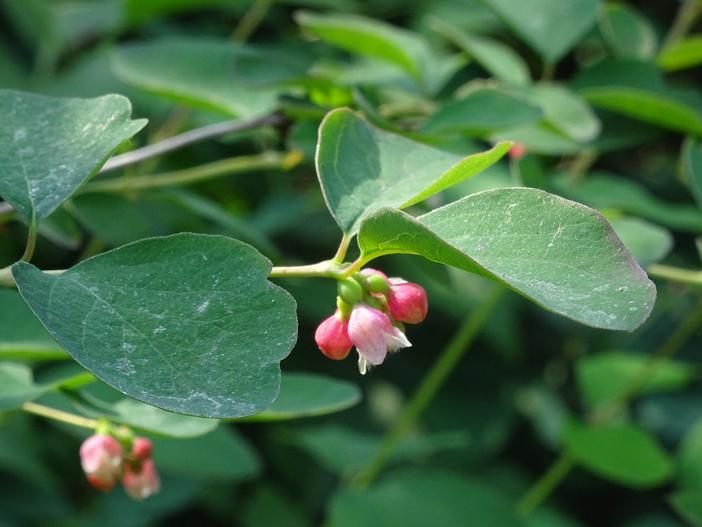Creeping Snowberry
(Symphoricarpos mollis)
Creeping Snowberry (Symphoricarpos mollis)
/
/

Olive Titus
PDM 1.0
Image By:
Olive Titus
Recorded By:
Copyright:
PDM 1.0
Copyright Notice:
Photo by: Olive Titus | License Type: PDM 1.0 | License URL: https://creativecommons.org/publicdomain/mark/1.0/ | Uploader: olive.titus | Publisher: Flickr







































































Estimated Native Range
Summary
Symphoricarpos mollis, commonly known as Creeping Snowberry, is a deciduous subshrub native to chaparral, coastal sage scrub, and forested areas of California, as well as regions in Northwestern Mexico and Nevada. This plant typically forms a low, spreading mat up to 1.5 feet tall, with flexible stems that can extend several feet in length. It features opposite leaves and produces clusters of small, bell-shaped flowers that are pink or red, followed by spherical, white or pink-tinged fruits that are notable for their soapy texture due to saponins. The fruits are not generally considered toxic but are unpalatable. Creeping Snowberry blooms from late spring to early summer, and while the flowers are modest, they can add a delicate charm to garden settings.
Creeping Snowberry is valued for its ability to provide dense ground cover, stabilize slopes, and its drought tolerance once established. It is often used in restoration projects, native plant gardens, and as an understory plant in shaded areas. This shrub is adaptable to a range of light conditions, from full sun to full shade, and prefers soils with medium to fast drainage. It requires low amounts of water, making it suitable for xeriscaping. While generally low-maintenance, it can spread via rhizomes, which should be considered when planting to prevent unwanted spread.CC BY-SA 4.0
Creeping Snowberry is valued for its ability to provide dense ground cover, stabilize slopes, and its drought tolerance once established. It is often used in restoration projects, native plant gardens, and as an understory plant in shaded areas. This shrub is adaptable to a range of light conditions, from full sun to full shade, and prefers soils with medium to fast drainage. It requires low amounts of water, making it suitable for xeriscaping. While generally low-maintenance, it can spread via rhizomes, which should be considered when planting to prevent unwanted spread.CC BY-SA 4.0
Plant Description
- Plant Type: Subshrub, Shrub
- Height: 0.5-2 feet
- Width: 1-5 feet
- Growth Rate: Slow
- Flower Color: Pink
- Flowering Season: Spring, Summer
- Leaf Retention: Deciduous
Growth Requirements
- Sun: Full Sun, Part Shade, Full Shade
- Water: Low
- Drainage: Medium, Fast
Common Uses
Bank Stabilization, Bee Garden, Bird Garden, Butterfly Garden, Deer Resistant, Drought Tolerant, Erosion Control, Fire Resistant, Groundcover, Hummingbird Garden, Low Maintenance
Natural Habitat
Native to chaparral, coastal sage scrub, and forested areas of California, Northwestern Mexico, and Nevada
Other Names
Common Names: Southern California Snowberry, Trip Vine
Scientific Names: , Symphoricarpos mollis, Symphoricarpos albus var. mollis, Symphoricarpos mollis var. mollis, Symphoricarpos acutus, Symphoricarpos albus subsp. mollis, Symphoricarpos ciliatus, Symphoricarpos mollis subsp. mollis,
GBIF Accepted Name: Symphoricarpos mollis Nutt. ex Torr. & Gray